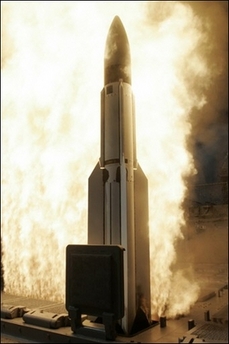US missile interceptor test launches debate
In space, a 15,000-mph collision between a missile and an interceptor rocket makes no noise. But down on Earth, a scientific and political debate is getting very loud.
 This 08 March 2006 US Department of Defense handout image shows a Standard Missile - 3 (SM-3) being launched from the USS Lake Erie (CG 70) in a Missile Defense Agency and Japan Defense Agency joint test in the Pacific. [Agencies] |
It's a technology that scientists say won't work effectively.
Such midcourse interceptors, designed to destroy their targets in space at their trajectory's peak, already are in place in Alaska and California.
A plan to place a $3.5 billion interceptor base in Poland by 2012 has generated friction with Russian President Vladimir Putin. Missile defense will be discussed at the G-8 summit June 6-8 in Germany.
The interceptor test is part of the agency's plan to spend $49 billion over the next five years to deploy and test missile defense technologies.
But physicists such as Frederic Lamb of the University of Illinois Urbana-Champaign, who co-headed a 2003 American Institute of Physics report on missile defense, are saying that midcourse interceptors are losers from a physics standpoint.
According to Lamb: Aside from the difficulty of the interceptor connecting with the missile when both are free-falling outside of the Earth's atmosphere, it will be impossible to detect a decoy missile. Atmospheric drag identifies the qualities of a missile, such as size, speed and heat. Without those signatures, a balloon, for example, would register on radar the same way a rocket would.
The test will take place about 100 miles above the Pacific Ocean, where the atmosphere is thin. Analysts consider anything above 62 miles altitude to be a region of diminished or non-existent air drag, says physicist David Wright of the Union of Concerned Scientists, a science advocacy group in Cambridge, Mass.
"Outside the Earth's atmosphere, the drag is zero on a warhead and a decoy alike," Lamb says. "This is an intractable problem. There is no signature that distinguishes a warhead that can't be cheaply counterfeited."
Lehner says by e-mail: "Critics forget that we have a variety of sensors that are extremely capable of discriminating countermeasures and decoys from lethal warheads."
Rep. Ellen Tauscher, D-Calif., chairwoman of the House Armed Services Subcommittee on Strategic Forces, says, "We've invested billions in missile defense since the 1980s." She favors more proven shorter-range missile defense systems: "It's got to be better than a science project."
相关文章
- 欧美文化:Russian FM visits Algeria to mark 60th anniversary of ties
- 欧美文化:Turkey, Kazakhstan aim to reach 10 bln USD in bilateral trade: president
- 欧美文化:Moroccan, Egyptian FMs discuss prospects of bolstering cooperation
- 欧美文化:Ukrainian president, Swedish PM discuss defense support for Ukraine over phone
- 欧美文化:Two suspects arrested for killing 3 Israelis in stabbing attack
- 欧美文化:Russia says 50 more civilians evacuated from Azovstal
- 欧美文化:Putin, Bennett discuss Ukraine over phone
- 欧美文化:U.S. FDA limits use of Johnson & Johnson COVID-19 vaccine over blood clot risk
- 欧美文化:U.S. secretary of state tests positive for COVID-19
- 欧美文化:Hungary "can't support" EU's new sanctions against Russia in current form:




 手机网站
手机网站